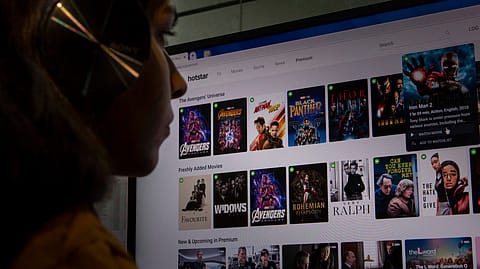From vernacular to viral and linear to digital: The boom of regional and digital entertainment
The entertainment consumption in India is rapidly transitioning from traditional television to digital platforms, primarily propelled by the rise of social media and OTT services.

India’s digital entertainment sector is witnessing a significant transformation, driven by the synergy of affordable internet access, strategic content initiatives and robust government support. The country ranks among the top three globally for the most cost-effective mobile data per GB. With the rapid deployment of 5G, India is projected to surpass 700 million 5G users by the end of 2028. A predominantly young, tech-savvy and mobile-first demographic is reshaping content consumption patterns. With a median age of 28.8 years and over 58% of the population under 35, these evolving trends are set to persist and expand. The widespread internet penetration, now exceeding 800 million users, has extended entertainment access to the country's farthest reaches, firmly establishing mobile devices as the preferred platform for media consumption.
Reel to real: How social and OTT are redefining entertainment
The entertainment consumption in India is rapidly transitioning from traditional television to digital platforms, primarily propelled by the rise of social media and OTT services. The era of appointment-based viewing is giving way to the convenience of on-demand content, offering audiences greater flexibility. Entertainment formats have diversified significantly, encompassing user-generated content, blogs, short videos, reels, OTT originals, audio streaming, social media sharing, online concerts, virtual festivals, live streaming and online gaming. India has over 490 million social media users, with individuals spending more than three hours daily on these platforms. YouTube, Facebook, Instagram and WhatsApp lead the pack, with YouTube users averaging over 29 hours per month. This strong engagement emphasises social media’s essential role in Indian daily life, influencing communication, entertainment and information sharing across the country.
The OTT revolution in India has been mainly driven by smartphone manufacturers and telecom operators, effectively providing millions with high-speed internet and streaming capabilities. Today’s audiences prefer the flexibility of streaming their favourite shows and movies anytime, anywhere, across a diverse and expanding ecosystem of domestic and international platforms. This shift also substantially affects the audio sector, with music and podcast streaming seeing unprecedented levels of user engagement. These trends clearly mark a move away from traditional media consumption, establishing India as a global leader in digital entertainment.
India's digital video universe has grown to over 545 million users. This growth is predominantly fuelled by the Advertising Video-on-Demand (AVOD) segment. Smartphones continue to be the main device for OTT consumption, with 97% of users accessing content through mobile devices. Despite the overall increase in viewership, active paid subscriptions have stabilised at around 99 million, indicating a growing trend among audiences towards free, ad-supported content models.
From heartlands to headlines: Regional content rules
In India, the entertainment audience on social media and OTT platforms is increasingly moving towards regional content, driving a significant shift in consumption patterns. Viewers are actively engaging with movies, web series and short videos in languages such as Tamil, Telugu, Hindi, Kannada, Bengali and Marathi, reflecting the country’s diverse linguistic landscape. Telugu, Tamil and Bengali OTT platforms have witnessed rapid growth, fuelled by demand for culturally resonant stories that mainstream Hindi or English content often does not fully capture. This regional content surge is complemented by social media trends where vernacular creators and influencers command massive followings, creating authentic, localised entertainment. Recent reports reveal that regional language content makes up over 50% of OTT consumption in India, emphasising how regional stories drive the digital entertainment revolution and broaden reach beyond metropolitan audiences.
According to a research report, over 70% of Indian viewers prefer watching content in languages other than those they speak. The preference is particularly strong in Tier 2 and Tier 3 cities, where vernacular content consumption surpasses that of national language content. Audiences are showing a growing preference for content in their preferred language. Regional language content has also gained popularity on the big screen, with Telugu, Tamil, Malayalam, Bengali and other language films performing well not only at the Indian box office but also internationally. Pushpa 2 (Telugu), Kalki 2898 AD (Telugu), Sookshmadarshini (Malayalam) and Bohurupi (Bengali) are some of the recent movies that have reinforced the compelling strength of authentic storytelling and language. This trend is further boosted by affordable smartphones and data, making regional content more accessible in urban and rural areas. The steady yet consistent rise of connected TVs is also initiating the start of a trend, especially in metropolitan regions.
India’s digital entertainment sector is thus poised for sustained growth, propelled by the accelerating shift toward online content consumption and the rising prominence of regional language programming. Offering strong cultural resonance and deeper audience engagement, regional content is set to play a pivotal role in shaping the future of entertainment. With the ongoing expansion of digital infrastructure into rural areas and Tier 2 and Tier 3 markets, the shift from traditional to digital media is expected to strengthen, establishing India as a global leader in digital and vernacular content consumption.
Views are personal. This article is written by Chandrashekar Mantha, Partner and Media & Entertainment Sector Leader, Deloitte India, and Kashyap Pathak, Executive Director, Deloitte India.